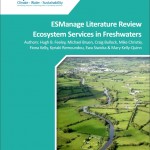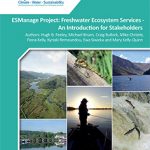The EPA has published Research Report No 187: ESManage Literature Review…
ESManage – understanding how to manage freshwaters and the ecosystem services they provide
Of all the ecosystems on the planet, freshwaters are under the greatest pressure and are likely the most endangered. Human activities affect freshwater resources extensively, in terms of both quantity, quality and biodiversity loss, despite the fact that our existence and quality of life depends so much on clean and sustainable freshwater resources.
In Ireland, for example, the 2016 EPA State of the Environment Report estimates that up to 50% of our freshwaters are impacted by pollution and other pressures, mainly from agriculture and municipal sources.
A key global challenge in the 21st century is to maintain the supply of clean water, food and other benefits derived from freshwaters without destroying the life-support natural capital and ecosystem processes that enable these supplies. These challenges, enshrined in the UN’s Sustainable Development Goals require that we not only identify what we derive from rivers, lakes, ground waters and associated wetlands but also to consider their value, monetary or otherwise, and how those values can be incorporated into policy and management decisions.
The goods and benefits we derive from our freshwaters are referred to as ecosystem services because they are enabled by the aquatic biological organisms and the various functions that they perform. For ease of understanding and to help capture the full range of ecosystem services they have generally been categorised as provisioning, regulating and maintenance, and cultural.
Provisioning services refer to goods that are consumed or used. The principal provisioning service in Ireland is the supply of water for drinking and non-drinking purposes, such as use in agriculture and industry. Pollution threatens the quality of this supply which has implications for the cost of treating water to the standard required for safe consumption but also quality in terms of taste and appearance. Freshwaters produce fish which are obviously a source of food in many countries, but apart from the aquaculture industry, wild fisheries in Ireland have a greater significance in terms of recreational angling than as a food resource.
Regulating and maintenance services are not as immediately obvious as the two other categories and therefore are often overlooked and consequently more difficult to value. They include those benefits that both directly (e.g. waste assimilation, pathogen control) and indirectly (e.g. regulation of decomposition, climate and flows) sustain environmental quality.
Cultural services on the other hand are readily appreciated by all of us. They include tangible recreational uses such as swimming, kayaking, angling, wildlife watching and walking along a river, and contribute to less tangible benefits, such as aesthetic or spiritual benefits, as well as educational value. These benefits can contribute significantly to good health and quality of our lives.
Currently the ESManage team is consulting the general public in three study catchments, the Dodder, Suit and Moy to gain insight into how people value a number of services such as water quality, water health, bankside vegetation, wildlife and angling.
You can read more about ecosystem services in a short Introduction for Stakeholders produced by ESManage, a project funded by the EPA which is harnessing the knowledge and tools required to embed the ecosystem services approach into policy and decision-making for sustainable management of water resources, as required by the Water Framework Directive. http://www.epa. ie/pubs/reports/research/water/research208.html
ESManage has also produced a report documenting the freshwater ecosystem services delivered by freshwater resources in Ireland and their relative importance to Irish society. It is available at http://www.epa.ie/pubs/reports/ research/water/research207.html
Mary Kelly-Quinn, UCD ESmanage Project
Further Information:
Follow @ESManage on Twitter or check out their website: http://www.ucd.ie/esmanage/
EPA 2016 State of the Environment report: http://www.epa.ie/irelandsenvironment/ stateoftheenvironmentreport/
United Nations Sustainable Development Goals: http://www.un.org/sustainabledevelopment/ sustainable-development-goals







